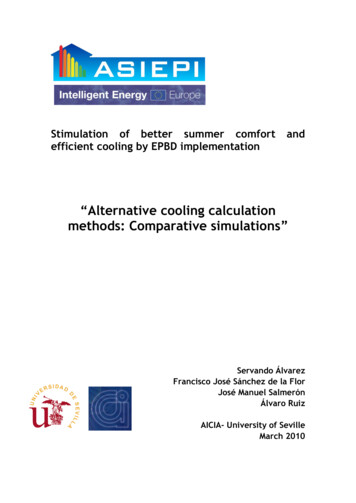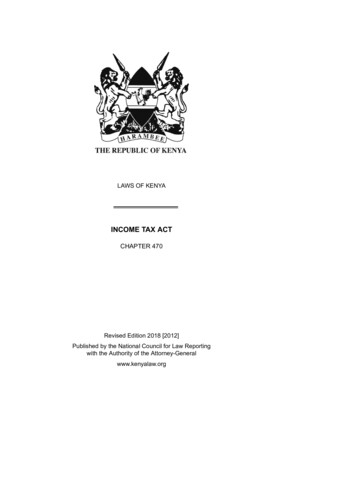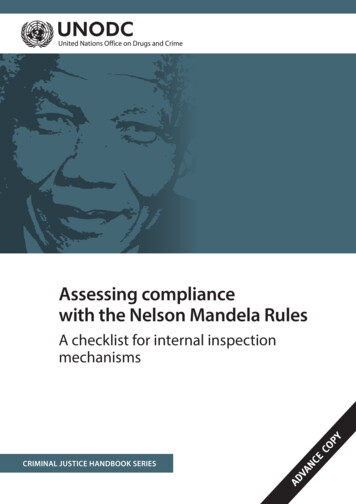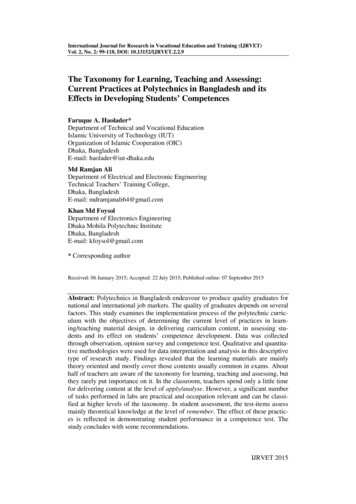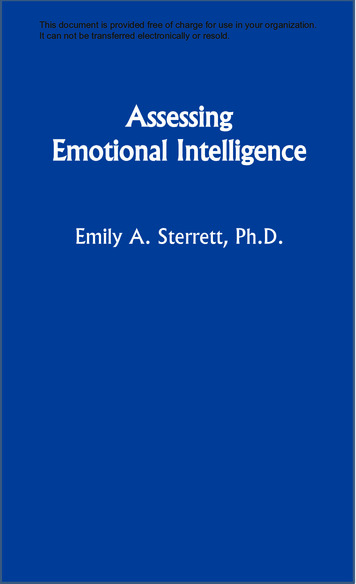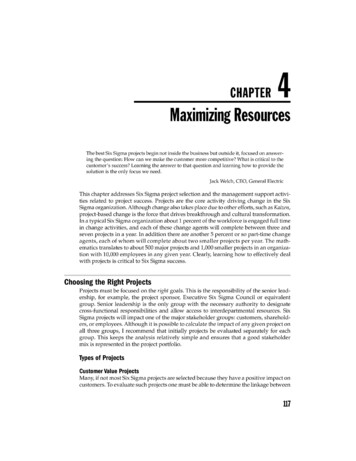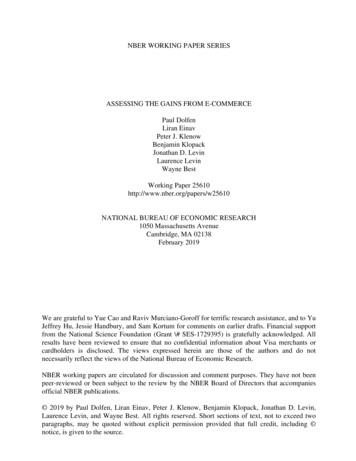
Transcription
NBER WORKING PAPER SERIESASSESSING THE GAINS FROM E-COMMERCEPaul DolfenLiran EinavPeter J. KlenowBenjamin KlopackJonathan D. LevinLaurence LevinWayne BestWorking Paper 25610http://www.nber.org/papers/w25610NATIONAL BUREAU OF ECONOMIC RESEARCH1050 Massachusetts AvenueCambridge, MA 02138February 2019We are grateful to Yue Cao and Raviv Murciano-Goroff for terrific research assistance, and to YuJeffrey Hu, Jessie Handbury, and Sam Kortum for comments on earlier drafts. Financial supportfrom the National Science Foundation (Grant \# SES-1729395) is gratefully acknowledged. Allresults have been reviewed to ensure that no confidential information about Visa merchants orcardholders is disclosed. The views expressed herein are those of the authors and do notnecessarily reflect the views of the National Bureau of Economic Research.NBER working papers are circulated for discussion and comment purposes. They have not beenpeer-reviewed or been subject to the review by the NBER Board of Directors that accompaniesofficial NBER publications. 2019 by Paul Dolfen, Liran Einav, Peter J. Klenow, Benjamin Klopack, Jonathan D. Levin,Laurence Levin, and Wayne Best. All rights reserved. Short sections of text, not to exceed twoparagraphs, may be quoted without explicit permission provided that full credit, including notice, is given to the source.
Assessing the Gains from E-CommercePaul Dolfen, Liran Einav, Peter J. Klenow, Benjamin Klopack, Jonathan D. Levin, LaurenceLevin, and Wayne BestNBER Working Paper No. 25610February 2019JEL No. L81,L86,O33,O47ABSTRACTE-Commerce represents a rapidly growing share of consumer spending in the U.S. We usetransactions-level data on credit and debit cards from Visa, Inc. between 2007 and 2017 toquantify the resulting consumer surplus. We estimate that E-Commerce spending reached 8% ofconsumption by 2017, yielding consumers the equivalent of a 1% permanent boost to theirconsumption, or over 1,000 per household. While some of the gains arose from saving travelcosts of buying from local merchants, most of the gains stemmed from substituting to onlinemerchants. Higher income cardholders gained more, as did consumers in more densely populatedcounties.Paul DolfenStanford Universityjpdolfen@gmail.comLiran EinavStanford UniversityDepartment of Economics579 Serra MallStanford, CA 94305-6072and NBERleinav@stanford.eduPeter J. KlenowDepartment of Economics579 Serra MallStanford UniversityStanford, CA 94305-6072and NBERKlenow@Stanford.eduJonathan D. LevinStanford UniversityDepartment of EconomicsStanford, CA 94305-6072and NBERjdlevin@stanford.eduLaurence LevinVISA Decision Sciences901 Metro Center BoulevardMail Stop: M3-2BFoster City , CA 94404-2775llevin@visa.comWayne BestVISA, Inc.900 Metro Center Blvd.Foster CityCA 94404wbest@visa.comBenjamin KlopackStanford UniversityDepartment of Economics579 Serra MallStanford, CA 94305-6072ben.klopack@gmail.comA data appendix is available at http://www.nber.org/data-appendix/w25610
2DOLFEN, EINAV, KLENOW, KLOPACK, LEVIN2 & BEST1.IntroductionAccording to the U.S. Census Bureau, E-Commerce spending doubled as a shareof retail sales from 2007 to 2017, reaching 10% of overall retail sales. In additionto large online-only megastores, many traditional brick-and-mortar retailershave launched online entities that sell the same products available in the retailers’ physical stores.For consumers, shopping online differs in important ways from visiting abrick-and-mortar store. Because online retailers are less constrained by physical space, they can offer a wider variety of products.1 E-Commerce also enablesconsumers to access stores that do not have a physical location near them. Finally, consumers can purchase a product online that they may have previouslypurchased at a brick-and-mortar store without making a physical trip. We referto these as variety gains and convenience gains, respectively.In this paper we attempt to quantify the benefits for consumers from therise of online shopping by leveraging a large and detailed dataset of consumerpurchases: the universe of Visa credit and debit card transactions between 2007and 2017. In 2017, roughly 22% of consumption flowed through Visa. Our datainclude detailed information on each transaction. We begin by describing thefeatures of this unique dataset and presenting some descriptive facts on thegrowth of E-Commerce.To quantify the convenience gains from E-Commerce, we posit a simplebinary choice model of consumer behavior in which consumers decide whetherto make a purchase at a given merchant’s online or offline channel. We showthat a consumer located farther away from a given merchant’s brick-and-mortarstore is more likely to buy online. We use this distance gradient, estimates ofthe cost of travel, and information on the distribution of distances of each merchant’s customers to estimate the convenience value of shopping online. Using1Brynjolfsson et al. (2003) found that the number of book titles available at Amazon was23 times larger than those available at a typical Barnes & Noble. Quan and Williams (2018)document a related pattern in the context of shoes.
ASSESSING THE GAINS FROM E-COMMERCE3this within-merchant substitution, we estimate that gains from conveniencereached no more than 0.4% of consumer spending by 2017.To quantify the variety gains from E-Commerce, we write down a model inwhich variety-loving consumers can adjust the number of merchants they visitonline and offline. The gains here are increasing in the share of spending online, and decreasing in the substitutability between online and offline spending.We estimate substitutability by exploiting how spending at online vs. offlinemerchants varies as a function of consumer distance to each offline merchant,again converting travel distance into dollars. We also use variation across cardsto estimate how much consumers are willing to trade off shopping at a greatervariety of merchants vs. spending more at each merchant. Within this framework, we estimate consumer gains from increased spending online to be about1.1% of all consumption by 2017. This is tantamount to 1,150 per householdin 2017. The gains are twice as large — even as a percent of consumption —for richer households (annual income above 50,000) than poorer households(below 50,000), and are higher in more densely populated counties.Our work is related to several papers that attempt to quantify the benefitto consumers from the internet. Goolsbee and Klenow (2006) develop an approach based on the time spent using the internet at home. Using estimates ofthe opportunity cost of time, they estimate surplus for the median consumer of2-3% of consumption. Brynjolfsson and Oh (2012) use a similar approach thatalso considers data on internet speed and the share of time spent on differentwebsites. They estimate the value from free digital services alone to be roughly1% of consumption. Varian (2013) estimates the value of time savings frominternet search engines. Syverson (2017) looks at the question of whether theobserved slowdown in labor productivity can be explained by mismeasurementof digital goods and ICT more generally. He concludes that surplus from ICT isnot large enough to explain much of the productivity slowdown, which exceeds1% per year for over a decade. Couture et al. (2018) study a program that increased internet access in Chinese villages and find more modest gains.
4DOLFEN, EINAV, KLENOW, KLOPACK, LEVIN2 & BESTOur paper also contributes to a broader literature that tackles the questionof how to measure consumer surplus from new products. Broda and Weinstein(2010) and Redding and Weinstein (2018) estimate the value of variety usingscanner data. Broda and Weinstein (2006) quantify the value of rising importvariety. Brynjolfsson et al. (2003) look at the gains to consumers from accessingadditional book titles at online booksellers.2The rest of the paper is organized as follows. Section 2 introduces the dataand how we construct some of the key variables. Section 3 presents summarystatistics and initial facts. Sections 4 and 5 estimate, respectively, the convenience and variety gains from E-Commerce. Section 6 briefly concludes. AnOnline Appendix provides details about samples, measurement of E-Commerce,the figures and tables, and solving the variety model.32.Data and Variable ConstructionOur primary dataset is the universe of all credit and debit card transactions inthe United States that were cleared through the Visa network between January2007 and December 2017.4 We complement the Visa data with data from amajor credit reporting bureau, as well as publicly available information at thecounty level from the U.S. Census and the Internal Revenue Service.Online Appendix A provides a detailed description of the data construction,and we attempt to summarize it here. The unit of observation in the raw datais a signature-based (not PIN-based) transaction between a cardholder and amerchant. We observe the transaction amount, the date of the transaction, aunique card identifier, the type of card (credit or debit), and a merchant identifier and ZIP code (as well street address in the most recent years). The merchant2Quan and Williams (2018) make and illustrate the important point that, if demand islocation-specific, then representative consumer frameworks can overstate variety gains.3See http://www.klenow.com/e-commerce-appendix.pdf4The Visa network is the largest network in the market. It accounted for 40 to 50% of creditcard transaction volume and over 70% of debit card volume over this period, with Mastercard,American Express, and Discover sharing the rest of the volume; see, e.g., ard-network/25531.
ASSESSING THE GAINS FROM E-COMMERCE5identifier is linked by Visa to the merchant’s name and industry classification(NAICS). In contrast, cards used by the same person or household are not linkedto each other, and information about the cardholder is limited to what onecould infer from the card’s transactions (with the exception of approximatelyhalf of the 2016 and 2017, which is matched to credit bureau data.)The 2007–2017 Visa data contain an annual average of 380 million cards, 35.9billion transactions, and 1.93 trillion in sales. Of these sales, 55% were credittransactions and 45% were debit transactions. Figure 1 presents Visa spendingas a share of U.S. consumption and nominal GDP, respectively. Visa volume hasbeen steadily increasing over time, from approximately 14% of consumptionin 2007 to almost 22% of consumption in 2017.5 In Section 4 below, where wefocus on substitution between online and offline channels within a merchant,we further limit the analysis to the five retail NAICS categories where the onlinetransaction share was between 10% and 90%.6Key variables. Each transaction indicates whether it occurred in person(“CP” for Card Present, meaning that the card was physically swiped) or not(“CNP” for Card Not Present). Roughly half of CNP transactions are broken further into E-Commerce, mail order, phone order, and recurring transactions. Wetreat phone, mail, and recurring transactions as offline. For CNP transactionswith missing breakdowns, we assume the E-Commerce fraction is the sameas the fraction of non-missing CNP values that is classified as E-Commerce.Online Appendix B provides more detail. Denoting ECI as the E-CommerceIndicator within CNP transactions, i as the 3-digit NAICS category, and t as the5Our analysis sample uses all transactions between 2007 and 2017 that pass standard filtersused by the Visa analytics team. We exclude transactions at merchants not located in the U.S.,those not classified as sales drafts, and those that did not occur on the Visa credit/signaturedebit network (transactions not involving sales drafts include chargebacks, credit voucher fees,and other miscellaneous charges.) We also drop cards that transact with fewer than 5 merchantsover the card’s lifetime, as many of the dropped cards are specialized gift cards.6Census Bureau NAICS codes 44 and 45 cover Retail Trade. Based on their onlinetransaction share in the Visa data, we use merchants in the following five categories to estimateconvenience gains: furniture and home furnishings stores; electronics and appliance stores;clothing and clothing accessories stores; sporting goods, hobby, musical instruments and bookstores; miscellaneous store retailers.
6DOLFEN, EINAV, KLENOW, KLOPACK, LEVIN2 & BESTFigure 1: Visa spending as a share of consumption and GDP22%20%Visa share of consumption18%16%14%12%Visa as a share of GDP10%8%2007 2008 2009 2010 2011 2012 2013 2014 2015 2016 2017Note: Visa credit and debit card spending; GDP and Consumption from the BEA.year, we infer E-Commerce spending within 3-digit NAICS category-years asE-Commerceit ECIit CNPit .ECIit phone/mail/recurringitTable 1 lists the NAICS categories that contain a nontrivial share of spending with the ECI flag. This includes many retail and some non-retail NAICScategories. It excludes NAICS categories such as Communication, which contains ample CNP spending on cell phone bills but which occurs predominantlythrough recurring payments. The non-retail NAICS categories with a significant ECI presence are all related to travel and transportation. We include theseNAICS categories in our analysis on the grounds that they provide convenienceand variety benefits akin to online options in retail NAICS categories (e.g. booking travel online rather than visiting or calling travel agent).
ASSESSING THE GAINS FROM E-COMMERCETable 1: E-Commerce categoriesRetail categoriesExampleNonstore RetailersAmazonClothingNordstromMiscellaneous RetailStaplesGeneral MerchandiseWalmartElectronicsBest BuyBuilding Material, Garden SuppliesHome DepotFurnitureBed Bath & BeyondSporting Goods, HobbyNikeHealth, Personal CareCVSFoodSafewayCar PartsAutoZoneNon-Retail categoriesExamplesAdmin. Support ServicesExpedia TravelAir TransportationAmerican AirlinesAccommodationMarriottGround TransportationUberRental ServicesHertz Rent-a-CarNote: NAICS categories that we classify as containing E-Commerce spending.7
8DOLFEN, EINAV, KLENOW, KLOPACK, LEVIN2 & BESTTwo other important variables in our analysis are card location and income.We infer a card’s preferred shopping location from its transaction history. Recallthat we observe the 5-digit ZIP code of the merchant for each offline transaction. We use this to define a card’s location as a longitude-latitude pair given bythe transaction-weighted average ZIP centroid.7 Using this card location variable, we then construct a distance variable for each offline transaction, whichis given by the straight-line distance between the longitude-latitude pair of thecard and the longitude-latitude pair of the merchant’s ZIP centroid (recall thatwe do not observe the merchant’s street address).For about 50% of the credit cards in 2016 and 2017, we have more preciseinformation about the cardholder residential address as well as income froma large credit rating agency. We use this location as a robustness check onour estimates with shopping centroid. We use income to break down onlinespending shares and the gains from E-Commerce by affluence.3.Summary Statistics and Initial FactsThe growth of online spending. We start by documenting the increasing importance of online spending during our sample. Table 2 documents the risingshare of online spending within Visa in selected NAICS categories. The onlineshare was already quite high in 2007 in some categories, such as air transport.And in some categories, such as food, the online share remained low in 2017.8To estimate the share of online spending in all U.S. consumption, we firstscale up Visa online spending by the inverse of Visa’s share in national creditand debit card spending. This assumes Visa spending is representative of allcard spending in terms of its online share, and that all spending online occursthrough debit and credit cards. Finally, we divide by overall U.S. consumption7We limit attention to ZIP codes in which the card transacted 20 or more times over the card’slifetime in order to omit transactions that were not part of the card’s primary purchasing area.This means that less active cards are excluded from our analysis that uses card location.8NAICS categories such as gasoline had essentially no online spending in either year.
ASSESSING THE GAINS FROM E-COMMERCE9Table 2: Visa online shares in select NAICS categories20072017Nonstore Retailers9096Air 237General Merchandise815Food56Note: % of Visa credit and debit card spending in select NAICS categories.of goods and services (including the service flow from housing):9U.S. online sharet Total U.S. card spendingt Visa online sharetU.S. ConsumptiontFigure 2 shows our estimates of the share of online spending in all consumption from 2007 and 2017, growing from about 5% of spending in 2007 to almost8% in 2017. Defined more narrowly using retail NAICS categories, the onlineshare rose from about 3.5% in 2007 to 5% in 2017.Heterogeneity by income and population density. There are two primary channels by which consumers likely benefit from the increased availability of theonline channel: convenience and availability. From a convenience perspective,E-Commerce allows consumers to avoid the trip to the offline store, and the potential time and hassle costs associated with parking, transacting, and carryinghome the purchased items. It seems plausible that these convenience benefitsare largest for more affluent consumers.The availability benefits might be particularly important for consumers who9We divide Visa’s credit and debit card spending by the estimate of nationalcredit and debit card spending at WalletHub.com card-network/25531). These estimates are based on the SEC filings ofthe major card companies.
10DOLFEN, EINAV, KLENOW, KLOPACK, LEVIN2 & BESTFigure 2: Estimated share of online spending in the U.S.Note: We estimate E-Commerce spending on the Visa network and extrapolateit to the the U.S. economy assuming: 1) that Visa is representative of all cardspending in terms of online share, and 2) all online spending is done usingcredit or debit cards. ‘All online’ refers to our baseline estimate of E-Commercespending in all consumer categories. ‘Retail online only’ refers to our alternativeestimate which only counts online spending in retail industries as E-Commerce.Total consumption (the denominator for each series) is from the BEA.live in more rural areas and smaller cities, where there are fewer offline merchants.10 E-Commerce is essentially available to everyone everywhere, thusmaking many more merchants available to consumers.Even though we observe (estimated) income for about one-half of Visa creditcards in 2016 and 2017 through a credit bureau, not all households have creditor debit cards. To adjust for the card-less, we scale down the Visa online spending share in a given county-income pair by the ratio of Visa cards to the numberof IRS tax return filers and dependents in that county-income pair:scy 10Visa online spendingcy· αcyTotal Visa spendingcySee Handbury and Weinstein (2014) for evidence that variety is greater in larger cities.
ASSESSING THE GAINS FROM E-COMMERCE11where scy is our estimate of the online share of all consumption for incomegroup y in county c, and αcy is our estimate of the share of households withcards in that group:αcy # of Visa CardscyTax FilerscyAgain, we are assuming online spending only occurs through credit and debitcards, so the cardless are not online at all. See Online Appendix C for details. Inthe final step we scale down all scy values so that they aggregate to our estimatedtotal U.S. E-Commerce share.We estimate an online share of 3.4% of consumption for households with incomes of 50k and below in 2017, and 9.7% of consumption for households withincomes above 50k. If we sort counties by 2010 Census population per squaremile, counties with above-median population density have a population-weightedaverage online share of 9.1% of consumption, whereas below-median countieshave an average online share of 6.4%. This is perhaps surprising because thedensity of brick-and-mortar retailers is increasing in population density.Figure 3 displays our online share estimates for all U.S. counties in 2017.Online penetration is distinctly higher in the Northeast and in the West andMountain regions than in the South or Midwest.4.Estimates of Convenience SurplusIn this section we focus on a specific gain from E-Commerce: avoiding travelto a physical store by buying the same basket of goods from the merchant’s ECommerce channel. Given E-Commerce provides a wider set of merchants thanwhat would otherwise be available to consumers, this direct convenience gainis surely be smaller than the overall gain, which accounts for merchant substitution. Yet, it seems natural to begin by assessing the gain from conveniencegiven that doing so is simpler and requires fewer modeling assumptions.
12DOLFEN, EINAV, KLENOW, KLOPACK, LEVIN2 & BESTFigure 3: Online shares by county in 2017Note: This figure displays the online share in each county calculated from the Visadata and adjusted by the propensity of county residents to use a credit card. Eachcard is placed in a county-income bin according to their home billing ZIP codeand estimated household income. We compute the online share for each countyincome bin from their Visa credit card spending and multiply it by the ratio of creditcard accounts to population in that county income bin, normalized to match ourestimate of the aggregate online share of spending. As a measure of population ineach county-income bin, we use IRS data on the number of tax filers. The plot showsthe online share (aggregated across cardholders of different incomes) within eachcounty. See Online Appendix C for more details.
ASSESSING THE GAINS FROM E-COMMERCE13Specification. To quantify these convenience gains, we estimate a simple binary choice between online and offline transaction. We assume consumersknow the prices and items they will buy from which merchants. We make thestrong assumption that prices are the same online and offline for a given merchant, consistent with evidence in Cavallo (2017). The only remaining choice isthus whether to transact online or offline.We assume utility for consumer i of buying online at merchant j isuoij γjo oij ,(1)where γjo is the average merchant-specific utility from the online channel and oijis an online consumer-merchant component, which we assume is drawn froma type I extreme value distribution, iid across merchants and consumers.We assume utility for consumer i of buying offline at merchant j isubij γjb β · distij bij ,(2)where γjb is the average merchant-specific utility from the offline channel, anddistij is the straight-line distance between the location of consumer i and thenearest store of merchant j.11 bij is an offline consumer-merchant component,which we assume is similarly drawn from a type I extreme value distribution,iid across merchants and consumers.Equations (1) and (2) give rise to a simple logit regression of an indicatorvariable that is equal to 1 for an online purchase (and 0 for an offline purchase)on distance distij and merchant fixed effects.Estimation and results. We estimate this logit specification on a random sample of 1% of all cards in 2017 for which we observe the home ZIP code. Tocapture merchants where the choice of online and offline is meaningful, weuse transactions in the five mixed-channel retail categories (described in the11The store location is recorded by Visa as a latitude-longitude pair, while the location of theconsumer is based on the centroid of the ZIP 4 billing ZIP code.
14DOLFEN, EINAV, KLENOW, KLOPACK, LEVIN2 & BESTprevious section) where the consumer was within 50 miles of the offline store.Table 3 presents summary statistics for this sample. Online transactions account for 15-30% of the overall number of transactions and for 25-40% of the total dollar amount, except for electronics where the online share of transactionsis much greater (47% of transactions). The most robust pattern in Table 3 is thedistance of the consumer to the nearest offline store, which is systematicallyshorter for offline transactions than for online ones. This is the key variationwhich we rely on in the analysis below.Table 3: Summary statistics by NAICS categoryNAICSSport, Music, andBooksMisc. .2650.3020.2530.2380.2200.393235.2(11.3 - 617.0)90.7(5.0 - 158.9)79.7(13.7 - 158.2)96.4(15.6 - 194.9)61.8(6.8 - 134.9)57.1(4.9 - 133.6)49.2(6.6 - 100.4)114.6(17.6 - 196.3)6.0(1.1 - 13.4)12.8(31.8 - 0.0)6.3(1.0 - 14.2)9.1(23.8 - 0.0)7.2(1.3 - 16.9)10.9(28.4 - 0.0)4.7(0.7 - 10.6)10.5(27.9 - 0.0)FurnitureElectronicsClothingNAICS 30.9(10.7 - 237.0)209.3(23.2 - 419.3)Online shareTransactionsSpendingTicket size (dollars):OfflineOnlineDistance to nearest offline store (miles):Offline7.0(1.1 - 16.5)Online8.7(1.4 - 21.4)The table shows summary statistics for the transactions used in the convenience analysis. The ticket size panel gives the averagedollars per transaction for each NAICS and channel (online or offline). Distance to the nearest store is calculated as the as-thecrow-flies distance between a consumer's location and the nearest offline branch of the merchant where the transaction wasmade. The first row in each of the bottom two panels contains the average ticket size or distance. The numbers below, inparentheses, are the 10th and 90th percentiles.Figure 4 pools across the five retail categories, and relates the online shareto distance in the raw data, as well as the estimated relationship using the logitspecification. As expected, the online share increases with distance. That is, asthe nearest brick-and-mortar store is further away, the online channel becomesrelatively more attractive, and the online share increases. Comparing caseswhere the offline store is nearby to cases where the offline store is 30-50 milesaway, the online share roughly triples, from approximately 14% to 45%.
ASSESSING THE GAINS FROM E-COMMERCE15Figure 4: Online share vs. distance to merchant storeNote: The figure shows the share of transactions that occur online as a function ofthe distance between the card and the nearest outlet of the merchant. The sampleincludes transactions made by 1% of cards in 2017 at merchants in the five mixedchannel NAICS categories listed in the data section. We include transactions atmerchants that had a location within 50 miles of the card’s billing ZIP code. Theblack line shows a bin scatter of the share of these transactions that occurred onlinein the raw data. Each point gives the average share of transactions that were onlinefor cards in a bin of size one mile. For example, the leftmost point on the blackline shows that cards that were between zero and one mile away from an outletof a merchant conducted about 12% of their transactions with that merchant inthe online channel. The grey line shows the predicted share of online transactionsfrom a logit regression of an indicator for whether the transaction was online on thedistance between the card and merchant and a set of merchant fixed effects.Using our logit specification, we estimate a β coefficient of 0.023 (with astandard error less than 0.00001), which implies that moving a consumer from10 to 20 miles away from a physical store increases the share of purchases madeonline by approximately 3 percentage points. Estimates of convenience gains.This simple model allows us to estimate the value of E-Commerce in a straightforward way. We can evaluate the consumer surplus from E-Commerce usingthe difference between consumer surplus when both online and offline options
16DOLFEN, EINAV, KLENOW, KLOPACK, LEVIN2 & BESTare available and when only the offline option is available. Applying the wellknown properties of the extreme value distribution, the convenience gain ofeach transaction by consumer i at merchant j isln[exp(γjb β · distij ) exp(γjo )] (γjb β · distij ). CSij β(3)We do not observe and therefore do not use prices in our analysis. Instead,we use travel distance as a determinant of the full price. To monetize miles, weassume that each mile costs 0.80 in time costs and 0.79 in direct costs, for atotal of 1.59 for each one-way mile and 3.18 for each round-trip mile betweenthe consumer and the store.12Applying equation (3) to all the transactions in our data, we obtain an average convenience gain (across all transactions in the sample) of 11.3 mile equivalents. Using the conversion factor above ( 3.18 per round trip mile), the convenience gain per transaction comes to 36 dollars.The average ticket size in our sample is 88 and the average distance between consumer and store is 7 miles. Thus convenience gains from the onlineoption are on the order of 32% for purchases in the five NAICS categories usedin the estimation. Together, transactions in these five categories made by consumers who were closer than 50 miles to an offline outlet of the same merchantmake up about 7% of all dollars, implying that the total convenience gains as ashare of Visa spending of about 2.2%, or roughly 0.4% of all consumption.12To obtain the monetary cost of a mile, we use estimates from Einav et al. (2016), who reportsummary statistics for a large number of short-distance trips of breast cancer patients. Theyreport that an average trip takes 10.9 minutes to travel 5.3 straight-line miles, with an actualdriving distance of 7.9 miles. The BLS reports that the average hourly wage from 2007–2017was 23 per hour after tax. As an estimate for the driving cost, we use the average of the IRSreimbursement rate from 200
ther into E-Commerce, mail order, phone order, and recurring transactions. We treat phone, mail, and recurring transactions as offline. For CNP transactions with missing breakdowns, we assume the E-Commerce fraction is the same as the fraction of non-missing CNP values that is classified as E-C

